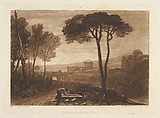Scene in the Campagna, part ViII, plate 38 from "Liber Studiorum"
Designed and etched by Joseph Mallord William Turner British
Engraver William Say British
Publisher Joseph Mallord William Turner British
Not on view
Turner distilled his ideas about landscape In "Liber Studiorum" (Latin for Book of Studies), a series of seventy prints plus a frontispiece published between 1807 and 1819. To establish the compositions, he made brown watercolor drawings, then etched outlines onto copper plates. Professional engravers usually developed the tone under Turner's direction, and Say here added mezzotint to describe a timeless scene near Rome where a woman, stripped to the waist, dips her hands into a water tank near figures that tend sheep. At right a river flows towards a tower, a classical temple and bridge. The letters "EP" in the upper margin likely stand for Elevated Pastoral and were applied by Turner to landscapes within the set that echo the Arcadian sensibility of Claude.
Due to rights restrictions, this image cannot be enlarged, viewed at full screen, or downloaded.


